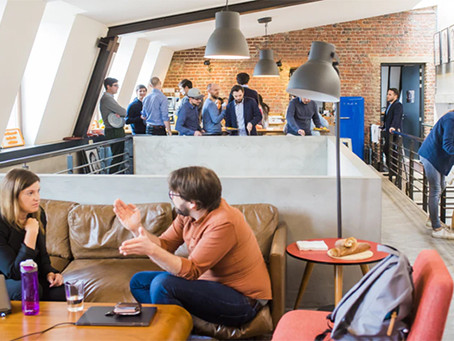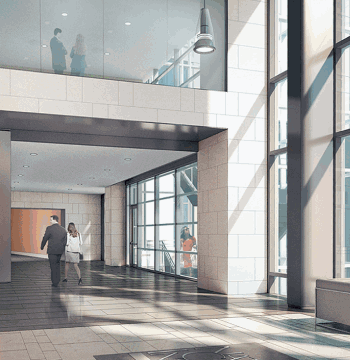22 Nov


Workplaces change.
As humans flow in and out of these built environments, they gradually project their personal desires for the design of the spaces within.
Workplace and HR managers need to stay intuitive to these desires because, eventually, they may crystallize into trends.
As you can imagine, COVID-19 pandemic was an agent of change to our market’s existing trends. It catalyzed the need for health, safety, and well-being in workplaces.
And it then opened a vista into a more human-centric future for the workplace.
Workplaces as a Human-Centric Choice
Kurt Von Koch, CEO of FM:Systems, a workplace experience solutions company, predicts a more remote-friendly work ethic. “Our interactions with the workplace, hospitals and schools are going to be radically changed. For the foreseeable future, we will see many more employees work from home. This will fundamentally alter the way offices are designed, built, and leased.”
The workplace is fast becoming a bespoke context. It is no longer a daily mandate. Given the power of remote working technologies, it is now a space where employees can choose to come to, for only 2-3 days a week.
Companies have to mull over how they can make their workplaces more desirable to employees. We are choosy about the tasks we do, the desks we sit on, and the colleagues we interact with. Workplaces need to reflect the best workplace design suggestions of their employees.
One such design suggestion is based on how we perform tasks.
Ordering Workspace Based on Tasks
How we use the workplace matters.
We have specific put-your-head-down tasks that are individual: just one person—you—can finish the job. We have collaborative tasks, when we need to share and combine information with other colleagues. We also have discussion-based tasks, like meetings, presentations, and conferences.
Von Koch explained that a workspace will reflect each type of task: “I also believe we will see the concept of “me” spaces and “we” spaces advance dramatically. This is an existing trend in our industry of creating “me” spaces for intense individual focus and “we” spaces for collaboration and energy.”
He emphasized on the collaborative spaces taking center stage, as employees prefer to perform their individual tasks within the walls of their home:
“My prediction is that we will see much of the typical office environment shift into a “we” space where you can go and collaborate with coworkers, get energy from those ideating around you, with companies investing in employee’s home offices for more ideal “me” spaces or focused areas of work happening at home.”
What Employers Need to Know About Employees
Naturally, within this emerging framework of bespoke workplace experience, employees are recognizing that they have more say when they work on-site. New ideas come and go, and many of them are worth looking into.
Employers need to be privy to the ideas that are emerging—how they can use them to retain employees, improve productivity, and create a perfect working environment. But they also need to practice prudence, for all preferences do not necessarily improve the workplace system.
There are methods of understanding what are the best ideas.
● Recognize Preferences with Analytics:
Before you can design your workplace to your employees’ preferences you need to know their preferences.
You can do this via different digital tools: visitor management systems, workplace experience management systems, and space management systems. Using these tools to measure different metrics is the one and only factor that should drive your management process.
They’ll help you understand preferences in how your employees think, move, and work. They measure so you can justify design changes. There are 3 factors that you will discern:
– Human flow: A comprehensive visitor management system can analyze how people enter, move around, and exit the workplace. You can collect visitor data, entry times, and enforce health screening through these systems. If people prefer coming in at one time and moving in a certain direction, you need to accommodate for that.
– Where people like to work: Other workplace management systems will measure which sections of the workplace are the most populated throughout the day. Once you understand why those sections create favorable experiences, you can try replicating their attributes in other sections. Variables like “Capacity” and “Desk Usage” can help you understand this.
– Appropriate Spacing: There are also “People Density” and “Desk Density” variables which will help you understand how people prefer being spaced. In the post-pandemic situation, people will still want relative privacy, and workplace managers need to create spaced-out floor plans that will keep them satisfied.
● Directly Survey your Employees:
There are several issues that may not come up in data analytics. These issues can be discerned by surveying the right people—your employees.
Employee feedback is simple. You just need to draft a questionnaire that extracts their honest opinions on every aspect of the workplace and how you can improve it. The drafting should be a slow, collective process that does not shirk its responsibility, inclusive of all management, employee, and staff categories, and even recurring service categories like contractors and delivery people.
To take an example, your survey may reveal that most people in your workplace think that using contact-necessary fingerprint readers at entry is unhealthy and time-consuming. This cannot show up on analytics unless you take a survey. In place, you can install a contactless access control system such as a QR-code-reader.
● Maximize the Workplace Plan:
Using the wealth of information from visitor management, workplace management, space management, and employee surveys, you can plan your workplace.
A powerful goal to strive for is space efficiency: turning underused spaces into teeming, useful ones. You could also try to emphasize Von Koch’s “we” spaces to improve employee collaboration. If the driving work mode for the future is hybrid, where the workplace is used primarily for interactive and collaborative work, and when individual work is permitted at home, “we” spaces are what your design process should focus on.
Once all this is done, your employees can enjoy the benefits of a workplace that is receptive to their needs. Harnessing the power of all the workplace management tools, from visitor management to space management, can only inform your decisions to reach a competent level of empathy. Company morale should always be a priority no matter what industry you are in!

Subscribe to our Newsletter
SALES AND DEVELOPMENT OFFICE
C-209/210, Mittal Commercia Premises Co. Op. Soc. Ltd., Near Mittal Estate, Andheri East,
Mumbai – 400059
HEAD OFFICE
+1 (631) 747 8588 [email protected]Suite 1902, 1212, Avenue Of the Americas, New York, NY 10036
© 2022 by VAMS GLOBAL.






